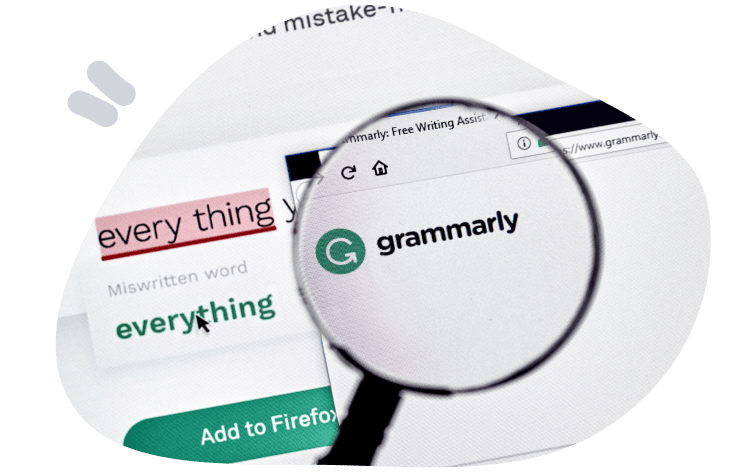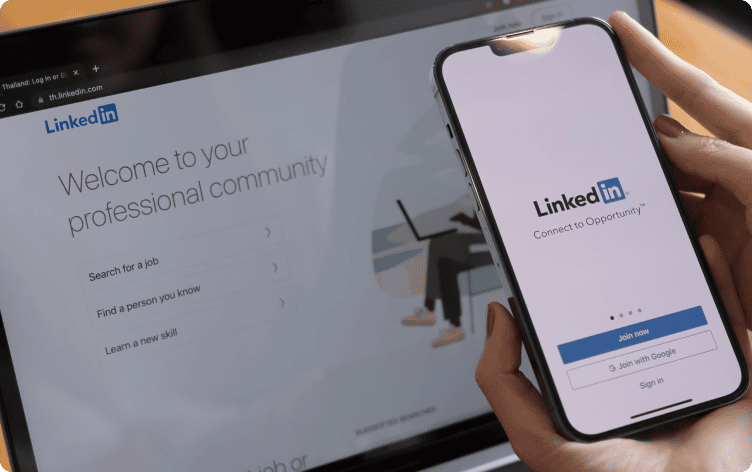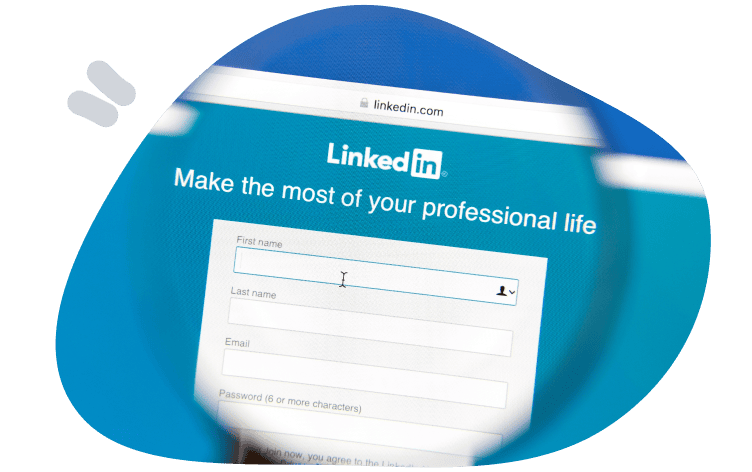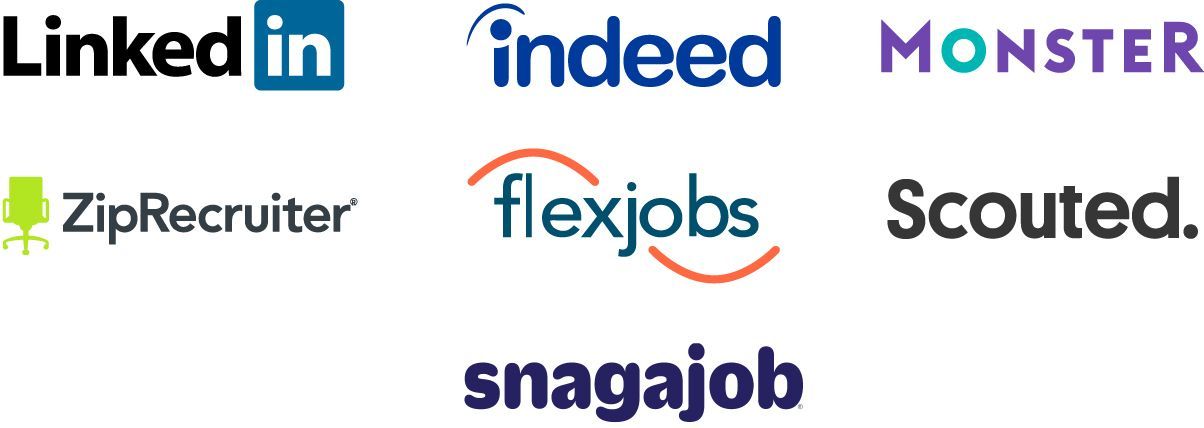
How To Ask for a Professional Reference
Find out how to ask for job references the right way. Get expert advice on approaching your contacts and making the most of their support.

Whether you’re unemployed, underemployed, or simply considering a career change, if you’re hoping to land a job interview, you’re in the right place!
First impressions are important—and it’s increasingly common for them to happen online.
Thanks to the internet, we can be social media detectives, finding and piecing together bits of information about people through various public profiles. Your potential future employer may be trying to learn more about you this way, too!
You only have around 7 seconds to make a good first impression.
Think about the details you’d notice if you were evaluating someone online. To a certain extent, we’re all guilty of “thin-slicing”, taking a quick mental evaluation of someone to predict their competence, confidence, and likability. People are inherently biased in that respect.
Anchoring is a type of cognitive bias that “describes the common human tendency to rely too heavily on the first piece of information offered (the ‘anchor’) when making decisions.”
Sound familiar? That’s because it’s the psychological basis of first impressions. Here are some tips to improve the likelihood of your first impression being a good one.

Your online profiles collectively form your personal brand. How do you want to portray yourself to the world—both professionally and personally? There’s a difference. How you choose to brand yourself online is a reflection of how you might brand the organization that’s considering hiring you.
Some social media sites and apps have a “view as” option that allows you to check what visitors see. When looking at your profiles, try to make an unbiased assessment of what version of yourself you’re presenting. Check your sharing permissions on social networks, and restrict access to information, photos, and videos.
So many aspects of modern jobs involve strong written communication. Emails should be well written. Typos and grammar mistakes on your profiles can jeopardize your attempt to come across as professional. Run your words through a free grammar checker.

Before you begin applying for jobs, work on the messaging you’ll use to promote yourself as a strong candidate. Make sure this is consistent throughout every stage of the hiring process: from the initial job application form, to your resume and cover letters. Every step is a new touchpoint for recruiters to learn more about why you’re a great fit for the position.
Now let’s talk about the specifics of sprucing up your LinkedIn profile.
LinkedIn is the world’s largest professional social networking site with over a billion members in more than 200 countries and territories worldwide. The platform is intended for professionals who are interested in networking, sharing ideas, sharpening skills, and gaining industry insights.
92% of companies use social media platforms to look up candidates.
Since so many recruiters and hiring managers use LinkedIn to assess potential employees, you want your profile looking sharp. Plan to put the same amount of effort into polishing your LinkedIn profile as you would your resume. If you don’t, you can come across as indifferent or oblivious about marketing yourself successfully online.

As you’re creating or improving your LinkedIn profile, begin with the most basic information of all: your name.
Some people don’t include their last name, but this can limit your discoverability on the platform. Make sure to add any relevant post-nominal letters(e.g., MBA, PMP, PhD). Just make sure you don’t add so many that it starts to look like alphabet soup!
The pronoun field is an optional feature of LinkedIn where members can add preferred gender pronouns next to their name. 70% of job seekers believe it’s important for people to know their gender pronouns, and 72% of hiring managers agree, believing it shows respect.
LinkedIn also has a feature that allows you to upload a recording of how to properly say your name. Some people use this feature to quickly introduce themselves, inviting visitors to connect with them. If you’re struggling with how to pronounce a recruiter or hiring manager’s name, check their profile to see if they’ve taken advantage of this feature, too.
Choose Pictures Worth 1,000 Words
The first thing people notice when they land on your LinkedIn profile are the photos you’ve chosen. Your profile photo and cover photo work together to showcase who you are.
When selecting a LinkedIn profile picture, make sure:

LinkedIn has a feature where you can add an “Open to Work” mention to your profile photo. It’s intended to let your network know that you’re looking for a job, but there is some debate about whether or not this is a good idea.
Recruiters may be turned off by the open-to-work designation, thinking you’re not in high-demand. Use your discretion.
Your LinkedIn Profile is essential for job searching. Over 98% of recruiters use LinkedIn and they expect to see a LinkedIn Profile that confirms what you are sharing on your resume. Have a current profile photo and a SEO-effective headline for search. Highlight results throughout your Experience and About sections. Comment on posts from the companies, industries, and recruiters that are connected to the jobs you want.

Linkedin job search coach & resume remodeler
Video is an excellent way for job seekers to stand out from other job candidates.
LinkedIn’s video cover story feature allows members to upload a short video of themselves. This is the perfect way to showcase your personality and demonstrate soft skills to recruiters and hiring managers. If you choose to do this, an orange ring will appear around your profile photo, and a preview of your video will auto-play silently within the photo frame, enticing visitors to watch it.
You may also want to experiment with Creator Mode, which visually displays examples of your best work, and Service Pages, which lists the services you offer.
This is particularly helpful if you’re open to freelance work or have a side hustle you’d like to promote. These LinkedIn options are a great way to make your profile more visual and engaging.
of hiring managers believe that video has become more important when vetting job candidates.
Now let’s consider the written parts of your profile. Your LinkedIn profile is a great place to express your passions, highlight your accomplishments, explain your journey, and touch on your career aspirations.
To guide recruiters through your career journey:
While you’re improving your profile, be attentive and try to minimize mistakes. Things like misspellings show carelessness. You want to demonstrate that you’re observant and show attention to detail—skills that can help improve your employability.
Use these tips to clean up your profile as best you can, and then ask someone you trust to look it over. Ask for direct feedback and make adjustments over time.

Let’s talk about how to maximize LinkedIn’s potential to stand out to recruiters and hiring managers.
Pro tip:
Resist treating your LinkedIn profile like other (non-career focused) social media platforms. Make every effort to remain professional—without losing your personality.
Start building your network by connecting with people you already know: your friends, family, people you’ve worked with (past and present), schoolmates, teachers, and mentors.
Then, gradually widen your network by reaching out to interesting people. You may discover influencers in your space, or chat with people who are a second- or third-degree connection.
Reach out with a personalized connection invitation. Mention something that stood out to you on the person’ profile, or tell them why you’d like to connect.
Share some context; don’t use the same invite for everyone. Keep building your network over time. You never know who you’ll meet, when your paths may cross, and what exciting, new doors the right connections may open.
As you build your network on LinkedIn, feel free to ask your connections to share a recommendation about you. This can be short and sweet, but public testimonials from people who can attest to your work ethic and winning personality do wonders in shaping the perception of potential employers.
You can also ask people in your LinkedIn network to endorse specific skills you have. When multiple people agree that you are skilled at X thing (and they’re willing to vouch for that!), it can help convince recruiters you have the necessary skills for the job.
Once you’ve made your LinkedIn profile as good as it can be, keep your profile relevant. Update it right away whenever something noteworthy happens, like you get a new certification or a promotion.
Even if you are happily employed, add a recurring reminder in your calendar to update it every few months. Stay active on the platform by sharing posts and articles, and by liking and commenting on others’ posts. Actively engaging on LinkedIn keeps your profile fresh and visible to a larger audience of people who can help you throughout your career.
Let’s take a look at the oldest job seeking tool in the book: the traditional resume.
The term CV (short for curriculum vitae) is more common in the U.K., but in North America, resumes are slightly different from CVs. A CV is usually a comprehensive document detailing your education, research experience, certifications, licenses, awards, and professional affiliations. Conversely, a resume is a short summary of your work history and skills.

First and foremost, be honest. While it’s fine to say you led a project or a team, recognize the work others completed with you, too.
Skip any photos of yourself, and omit your full address.
of recruiters will automatically dismiss a resume if it contains typos.
of the time resumes will be rejected because of an unprofessional email address.
Make sure your contact information is correct. Include the best phone number for people to reach you, as well as a professional email address. Warning: if you’re still using something like partyguy90@gmail.com, it’s 100% time to open a new email address for work-related purposes.
Add a link to your website or LinkedIn profile. Your resume alone is a great high-level document—and it’s made even better when hiring teams can click through to learn more about you online.
Change up the outdated “objective” section of your resume. Instead, write a new summary statement. Here’s the subtle difference: an objective says what you want out of the role, while a summary statement says what you can bring to the position—that’s what recruiters want to know.
Of course, a big part of your resume consists of your work experience. There are three ways to display this kind of information:
1. Chronological
2. Functional
3. Combination
Regardless of which format you choose, your resume should be no more than one (at the absolute most two) pages. If it’s longer than that, it’s time to cut the fat.
We recommend using the Laszlo Bock’s formula when writing about your expertise and work experience. Laszlo Bock is a former Google senior vice president of personnel operations who promoted the idea of framing your work in this way:
Accomplished [X] as measured by [Y] by doing [Z]
Create a bullet list of your job responsibilities, leading with what you’re most proud of or what takes the most of your time during work hours. Focus on the important activities, and omit trivial duties and occasional tasks.
Begin each bullet with a descriptive action verb in the present tense for your current job(s) (e.g., manage, coordinate, create) and past tense for work you’re no longer doing (e.g., supervised, assisted, succeeded).
A lot of job seekers are not familiar with the term ATS, an abbreviation of applicant tracking system. However, all recruiters know about this technology—and most of them use it, too.
Over 98% of Fortune 500 companies use an ATS of some kind. Many smaller businesses do, too.
If your resume is not scannable, you cut your odds of advancing to the next stage of consideration by 60%.
The intended purpose of an ATS is to keep track of those who apply for work at a particular organization. An ATS scans and filters incoming resumes, forwarding only the most “best fit” resumes to hiring teams.
Some resumes are more difficult to scan than others. It helps to understand the basics of resume-scanning technology. Over-designed resumes are also harder for applicant tracking systems to read. Send your resume as a Word Document (.docx) or .PDF when possible.
Most ATS algorithms look for specific keywords, especially words matching those used in the job description. To increase the likelihood that your resume passes the ATS test, try to incorporate skills that come up more than once in the job posting or appear near the top of the requirements and responsibilities sections.
The wrong resume formatting and a poor layout make or break your chances of landing a job interview. Here are some ideas to modernize and refresh your resume.
Have you considered creating a video resume? This format can be a great accompaniment to a traditional resume, especially within creative professions such as graphic design, videography, and fashion.
While video resumes are usually optional, they are becoming as commonplace as video interview software.
of job seekers feel sharing a video with hiring managers allows them to better highlight their personality.
If you decide to make a video resume, keep it between one and two minutes. You can use some of the messaging you’ve perfected while improving your resume, but don’t just repeat it word for word.
Speak directly into the lens of your camera, introduce yourself, and explain why you applied for the job and what you can offer that employer.
Invite them to contact you to learn more—you could also use video editing software to splice in examples of your work. Once finished, consider uploading your video resume onto YouTube. This way, you’ll have a link you can add to your resume or LinkedIn profile, making the video easier to share with prospective employers.

Cover letters used to be mandatory in almost any search for employment, but times are changing. Some employers don’t ask for them anymore, and many job seekers think there are modern alternatives.
of job seekers believe a recorded video could be the next iteration of the traditional cover letter.
However, submitting a cover letter is still part of many application processes—especially for jobs that require strong writing skills. Since cover letters are often encouraged, here are some tips for when you write them.
Good cover letters say a lot in a short amount of space. They’re concise and show the value you bring to the table. Most cover letters follow a three-to-five-paragraph format where you briefly introduce yourself and summarize what makes you a good fit for the position.
Show some passion and personality. Your cover letter should be no more than one page—sometimes even half a page is enough to land a job interview.
Your cover letter should be customized for each of the roles you’re applying for. So, it’s not a good idea to copy and paste the title of the position or add something generic like ‘To Whom it May Concern’ at the top.
Make an effort to personalize each cover letter as much as you can. Do some research and include the hiring manager’s name (or at least address the letter to a specific department head).
If any details in the job description stood out to you, mention them here. Some employers will ask you to include a reference number within your cover letter, so read the instructions carefully.
Don’t make the cover letter all about you. Employers already know you’ll benefit from getting the job. They want to learn what you can bring to the role and company as a whole.
This is an opportunity for you to make that pitch and stand out from other candidates.
Instead of starting your cover letter with a generic line such as ‘I am submitting my candidacy for X role,’ get the reader’s attention with a more unique opener.
Flatter the organization, make a reference to a recent blog post or company development, and always align what you have to offer with the organization’s needs.

Lissa Appiah
Certified resume & career strategist, WeApplyAfter you’ve completed a draft, shift your attention to another project and then, later, look at your cover letter with fresh eyes. This often makes it easier to spot typos and grammar mistakes, which can shortchange your best efforts. You may want to ask someone else to review it as well, making revisions until it’s the best it can be. Once you’re happy with your cover letter, save the file so that its title matches how you saved your resume (e.g., Leslie-Knope-Cover-Letter). Make it easy for recruiters to see what the attachment is.
Now that you’ve got the fundamentals in place to market yourself to employers—a killer cover letter, a professional resume, and an engaging LinkedIn profile—it’s time to apply for work.
Remember, tailor your cover letter and resume to each of the positions you’re applying for.
Start your career search by creating a list of organizations where you’d love to work. If you’re not sure where to begin, do some employer research on a site like Glassdoor.
Once you’ve got a shortlist, check the career sections of the company websites to see if there are any openings.
As part of the ‘hidden job market’, an estimated 70% of jobs are not advertised.
If you really want to work somewhere, don’t rule it out simply because there are no public listings. Try to find contact information for someone on the hiring team, and reach out to them as you would any employer with open positions.
The job(s) you apply for will depend on your profession and where you are in your career. Some of the most popular sites for finding work include:

A big part of securing fulfilling work is networking with the right people.
85% of all jobs are filled via networking.
Start with a ‘foot in the door’ technique. Who do you already know in the industry or company where you’d like to work?
Reach out to friends and coworkers who might be able to help you in your job search. For more info, reference the ‘Making the Most of LinkedIn’ section of this article (particularly the part about how to build your network).
There was a time when employees typically kept the same job for many years—or even their whole life! Now, employees hold an average of 12 different jobs in their lifetime.

You’ve already done the hard work of preparing and perfecting your resume, cover letter, and online presence.
So, is it the right time to take a measured risk? If you’ve been thinking about pursuing a different line of work, now’s your chance.
Don’t let people tell you that you can’t pivot. You aren’t doomed to a lifetime of a career you don’t want. It’s simple…if you have the skills, apply.

Adam Karpiak
President, Karpiak ConsultingProfessional development is an ongoing pursuit that doesn’t stop in the early years of your career. You want to proactively seek out opportunities to upskill and maintain a strong work ethic as your career advances.

⅓ of your life is spent at work.
You’ll spend ~90,000 hours at work over a lifetime.
Often, it boils down to who you are as a person and how that measures up to your career aspirations. There’s lots of work one can do in this respect. You may collaborate with a mentor or career coach. Or, perhaps you prefer to take a virtual course on interviewing skills, like speaking and active listening.
Professional development sometimes comes down to working on yourself on a personal level, too. Consider seeing a counselor, psychologist, or psychiatrist. Work with someone the same way an Olympic swimmer works with someone to keep getting better at their craft. It’s about working with our minds—not against them—to be the best possible version of ourselves.

Jonathan Tesser
Career Whisperer for Young AdultsThroughout your job search, try your best to persevere and stay positive, even when you’re rejected. Your next in-person or video interview could be right around the corner.
Think of your career search like matchmaking. It’s a two-way street in that respect—while rejection is never fun, it is part of life. There are many fish in the sea, as are career paths and opportunities awaiting you.
If it turns out that’s not the path for you, pick yourself up and carry on with confidence and professionalism. Keep believing in yourself.
Happy job hunting!
Ensure your profile is complete, with a professional photo, compelling headline, and detailed summary. Highlight experience, skills, and achievements, and include relevant keywords to improve visibility in recruiter searches.
Tailor your resume for each job and focus on relevant experience and quantifiable achievements. Use a clean, ATS-friendly format and incorporate keywords from the job description to increase your chances of being noticed.
Your cover letter should be personalized to the job, showcasing your enthusiasm for the role and the company. Highlight achievements and explain how your skills and experience align with the job requirements.
Networking is crucial for uncovering hidden job opportunities. Attend industry events, connect with professionals on LinkedIn, and let your network know you’re actively seeking a new role.
Use major job boards like Indeed and LinkedIn, but also explore niche, industry-specific job sites. Regularly check company websites for direct listings, and set up alerts to stay informed about new postings.
Modernize your hiring process with expert insights and advice.